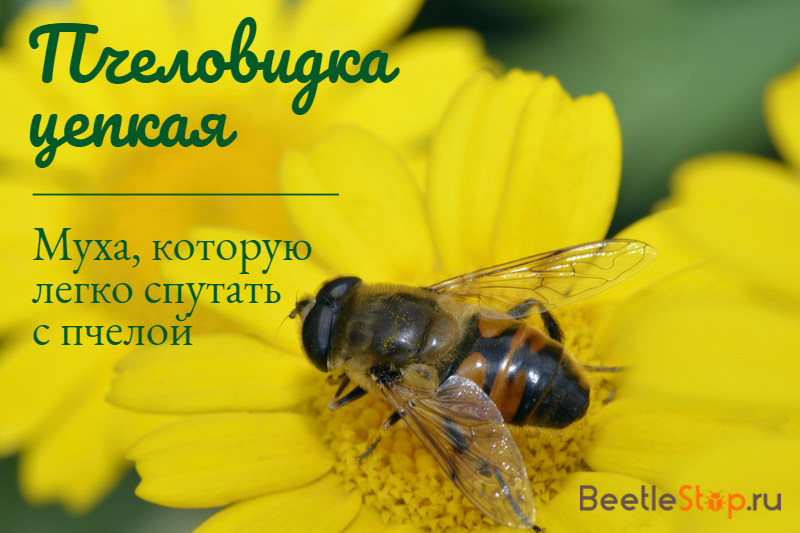Tenacious bee - a fly pretending to be a bee
Beetles or syrfids are similar in appearance to small wasps, but are flies. In the world there are 6 thousand species of these diptera insects. They live on all continents except Antarctica, avoid the desert and the tundra. A tenacious bee or common lhylidae is one of the types of germs. Adults feed on flowers, and larvae live in ponds. Accidentally entering the human body, caudate parasites cause myiasis.
Morphological description of the species
The bee-chain, common broom (Eristalis tenax) belongs to the family of beetles (syrphids), the genus of the bee-like. The body length of the imago is 14-16 mm. The head is round, most of the eyes are located on the sides. Face with a wide black stripe. The eyes are provided with vertical stripes of thick hairs. Arista naked, short antennae, black.

Information. The outward resemblance of the common oyster to a bee serves as a defense against enemies. Birds do not notice the absence of a second pair of wings and short antennae.
The chest is brown, covered with thick grayish-brown hairs. The wings are transparent, while hovering over the flowers emit a peculiar noise. The abdomen is brown with black patches, red-yellow stripes on the sides. The abdomen is covered with short hairs. The hips of the extremities are black, the tibiae and tarsi are brown or light. Insects are completely harmless. They do not bite or sting. They feed on nectar of flowers; in the garden they prefer dill and carrots.
Distribution area
Ilnitsa tenacious refers to cosmopolitans. Insects are common in Europe, Asia, Australia and Oceania. Creepers were brought to South and North America, where they took root perfectly. The wide habitat is explained by endurance and a tendency to migration.
Lifestyle
Bee summers are July – October. Insects rise to a considerable height - up to 5 m. The main part of the day is spent on flowers, they prefer hot sunny weather. Adults remain wintering, hiding in caves, crevices of old buildings, under plant debris. After mating, females are sent to dirty reservoirs rich in organic matter. They lay 200 eggs at a time.
Larval development
From cylindrical white eggs laid near a muddy pond, gutter or muddy puddle, small larvae appear after 2-4 days. They have a cylindrical body with a long tail, which is a telescopic breathing tube. The bee larvae are tenacious without eyes, the head section is underdeveloped. The oral organ is represented by a fold. There are small outgrowths on the body - seven pairs of false legs with hooks.
Information. The dirty gray color and the characteristic shape of the body with a long tail became the reason for the name of the larvae as rats.
The integuments of the body are transparent, if you wash the larva from dirt, internal organs become visible. In this case, the insect is extremely resistant to external influences. this feature allows you to survive in a polluted environment. The respiratory tube consists of three segments. It is capable of stretching and folding. Being in a dirty liquid, the rat exposes its tail to the surface for breathing. It feeds on organic residues deposited on stones and other objects, swallows them from the water.
Interesting fact.The breathing tube can reach a length of 15-20 cm, while the body of the larva does not exceed 2 cm.
For pupation, the larva is selected on land and buried in the ground. In search of a secluded place creeps into barns and farms. The transformation takes place in a larval skin, which gradually changes color to red-brown. The pupal phase takes 10-14 days, then a young fly appears.
Danger to humans
Larvae of the genus Eristalis are not parasites. But bee eggs laid on food can be swallowed by humans. When swimming in a dirty pond, there is a chance that larvae will enter the body. An alternative infection is laying the eggs by the female near the anus. Being in the rectum, it irritates the walls of the organ with its breathing tube. The resulting myiasis is called crystallization. The disease is registered in India, Australia, South America and some European countries - Denmark, Belgium, Spain.
Symptoms of the disease: diarrhea, vomiting, abdominal pain, itching in the anus. In some cases, symptoms do not occur. The disease is treated with medication, metronidazole and nifuroxazide are prescribed.
Fishing cap
Winter fishing enthusiasts use bee larvae as nozzles. Put them on small hooks several at a time. On rats breams are well caught. In puddles and reservoirs where larvae are found, fishermen catch them in large quantities so that there is enough stock for the whole winter. Collect them in a bucket along with silt from the habitat.

